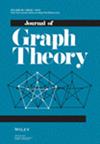求助PDF
{"title":"求解Turán长周期数的局部化方法","authors":"Kai Zhao, Xiao-Dong Zhang","doi":"10.1002/jgt.23191","DOIUrl":null,"url":null,"abstract":"<p>Let <span></span><math>\n <semantics>\n <mrow>\n \n <mrow>\n <mi>G</mi>\n </mrow>\n </mrow>\n <annotation> <math xmlns=\"http://www.w3.org/1998/Math/MathML\" altimg=\"urn:x-wiley:03649024:media:jgt23191:jgt23191-math-0001\" wiley:location=\"equation/jgt23191-math-0001.png\"><mrow><mrow><mi>G</mi></mrow></mrow></math></annotation>\n </semantics></math> be a simple graph and <span></span><math>\n <semantics>\n <mrow>\n \n <mrow>\n <msub>\n <mi>c</mi>\n \n <mi>G</mi>\n </msub>\n \n <mrow>\n <mo>(</mo>\n \n <mi>e</mi>\n \n <mo>)</mo>\n </mrow>\n </mrow>\n </mrow>\n <annotation> <math xmlns=\"http://www.w3.org/1998/Math/MathML\" altimg=\"urn:x-wiley:03649024:media:jgt23191:jgt23191-math-0002\" wiley:location=\"equation/jgt23191-math-0002.png\"><mrow><mrow><msub><mi>c</mi><mi>G</mi></msub><mrow><mo>(</mo><mi>e</mi><mo>)</mo></mrow></mrow></mrow></math></annotation>\n </semantics></math> denote the length of the longest cycle containing an edge <span></span><math>\n <semantics>\n <mrow>\n \n <mrow>\n <mi>e</mi>\n </mrow>\n </mrow>\n <annotation> <math xmlns=\"http://www.w3.org/1998/Math/MathML\" altimg=\"urn:x-wiley:03649024:media:jgt23191:jgt23191-math-0003\" wiley:location=\"equation/jgt23191-math-0003.png\"><mrow><mrow><mi>e</mi></mrow></mrow></math></annotation>\n </semantics></math> if there exists a cycle containing <span></span><math>\n <semantics>\n <mrow>\n \n <mrow>\n <mi>e</mi>\n </mrow>\n </mrow>\n <annotation> <math xmlns=\"http://www.w3.org/1998/Math/MathML\" altimg=\"urn:x-wiley:03649024:media:jgt23191:jgt23191-math-0004\" wiley:location=\"equation/jgt23191-math-0004.png\"><mrow><mrow><mi>e</mi></mrow></mrow></math></annotation>\n </semantics></math>, and 2 otherwise. We prove that the summation of 2 divided by <span></span><math>\n <semantics>\n <mrow>\n \n <mrow>\n <msub>\n <mi>c</mi>\n \n <mi>G</mi>\n </msub>\n \n <mrow>\n <mo>(</mo>\n \n <mi>e</mi>\n \n <mo>)</mo>\n </mrow>\n </mrow>\n </mrow>\n <annotation> <math xmlns=\"http://www.w3.org/1998/Math/MathML\" altimg=\"urn:x-wiley:03649024:media:jgt23191:jgt23191-math-0005\" wiley:location=\"equation/jgt23191-math-0005.png\"><mrow><mrow><msub><mi>c</mi><mi>G</mi></msub><mrow><mo>(</mo><mi>e</mi><mo>)</mo></mrow></mrow></mrow></math></annotation>\n </semantics></math> over all edges in an <span></span><math>\n <semantics>\n <mrow>\n \n <mrow>\n <mi>n</mi>\n </mrow>\n </mrow>\n <annotation> <math xmlns=\"http://www.w3.org/1998/Math/MathML\" altimg=\"urn:x-wiley:03649024:media:jgt23191:jgt23191-math-0006\" wiley:location=\"equation/jgt23191-math-0006.png\"><mrow><mrow><mi>n</mi></mrow></mrow></math></annotation>\n </semantics></math>-vertex graph <span></span><math>\n <semantics>\n <mrow>\n \n <mrow>\n <mi>G</mi>\n </mrow>\n </mrow>\n <annotation> <math xmlns=\"http://www.w3.org/1998/Math/MathML\" altimg=\"urn:x-wiley:03649024:media:jgt23191:jgt23191-math-0007\" wiley:location=\"equation/jgt23191-math-0007.png\"><mrow><mrow><mi>G</mi></mrow></mrow></math></annotation>\n </semantics></math> is at most <span></span><math>\n <semantics>\n <mrow>\n \n <mrow>\n <mi>n</mi>\n \n <mo>−</mo>\n \n <mn>1</mn>\n </mrow>\n </mrow>\n <annotation> <math xmlns=\"http://www.w3.org/1998/Math/MathML\" altimg=\"urn:x-wiley:03649024:media:jgt23191:jgt23191-math-0008\" wiley:location=\"equation/jgt23191-math-0008.png\"><mrow><mrow><mi>n</mi><mo>\\unicode{x02212}</mo><mn>1</mn></mrow></mrow></math></annotation>\n </semantics></math>, and characterize all <span></span><math>\n <semantics>\n <mrow>\n \n <mrow>\n <mi>n</mi>\n </mrow>\n </mrow>\n <annotation> <math xmlns=\"http://www.w3.org/1998/Math/MathML\" altimg=\"urn:x-wiley:03649024:media:jgt23191:jgt23191-math-0009\" wiley:location=\"equation/jgt23191-math-0009.png\"><mrow><mrow><mi>n</mi></mrow></mrow></math></annotation>\n </semantics></math>-vertex extremal graphs that achieve the bound, thereby extending the classic Erdős–Gallai theorem on cycles.</p>","PeriodicalId":16014,"journal":{"name":"Journal of Graph Theory","volume":"108 3","pages":"582-607"},"PeriodicalIF":1.0000,"publicationDate":"2024-10-08","publicationTypes":"Journal Article","fieldsOfStudy":null,"isOpenAccess":false,"openAccessPdf":"","citationCount":"0","resultStr":"{\"title\":\"A localized approach for Turán number of long cycles\",\"authors\":\"Kai Zhao, Xiao-Dong Zhang\",\"doi\":\"10.1002/jgt.23191\",\"DOIUrl\":null,\"url\":null,\"abstract\":\"<p>Let <span></span><math>\\n <semantics>\\n <mrow>\\n \\n <mrow>\\n <mi>G</mi>\\n </mrow>\\n </mrow>\\n <annotation> <math xmlns=\\\"http://www.w3.org/1998/Math/MathML\\\" altimg=\\\"urn:x-wiley:03649024:media:jgt23191:jgt23191-math-0001\\\" wiley:location=\\\"equation/jgt23191-math-0001.png\\\"><mrow><mrow><mi>G</mi></mrow></mrow></math></annotation>\\n </semantics></math> be a simple graph and <span></span><math>\\n <semantics>\\n <mrow>\\n \\n <mrow>\\n <msub>\\n <mi>c</mi>\\n \\n <mi>G</mi>\\n </msub>\\n \\n <mrow>\\n <mo>(</mo>\\n \\n <mi>e</mi>\\n \\n <mo>)</mo>\\n </mrow>\\n </mrow>\\n </mrow>\\n <annotation> <math xmlns=\\\"http://www.w3.org/1998/Math/MathML\\\" altimg=\\\"urn:x-wiley:03649024:media:jgt23191:jgt23191-math-0002\\\" wiley:location=\\\"equation/jgt23191-math-0002.png\\\"><mrow><mrow><msub><mi>c</mi><mi>G</mi></msub><mrow><mo>(</mo><mi>e</mi><mo>)</mo></mrow></mrow></mrow></math></annotation>\\n </semantics></math> denote the length of the longest cycle containing an edge <span></span><math>\\n <semantics>\\n <mrow>\\n \\n <mrow>\\n <mi>e</mi>\\n </mrow>\\n </mrow>\\n <annotation> <math xmlns=\\\"http://www.w3.org/1998/Math/MathML\\\" altimg=\\\"urn:x-wiley:03649024:media:jgt23191:jgt23191-math-0003\\\" wiley:location=\\\"equation/jgt23191-math-0003.png\\\"><mrow><mrow><mi>e</mi></mrow></mrow></math></annotation>\\n </semantics></math> if there exists a cycle containing <span></span><math>\\n <semantics>\\n <mrow>\\n \\n <mrow>\\n <mi>e</mi>\\n </mrow>\\n </mrow>\\n <annotation> <math xmlns=\\\"http://www.w3.org/1998/Math/MathML\\\" altimg=\\\"urn:x-wiley:03649024:media:jgt23191:jgt23191-math-0004\\\" wiley:location=\\\"equation/jgt23191-math-0004.png\\\"><mrow><mrow><mi>e</mi></mrow></mrow></math></annotation>\\n </semantics></math>, and 2 otherwise. We prove that the summation of 2 divided by <span></span><math>\\n <semantics>\\n <mrow>\\n \\n <mrow>\\n <msub>\\n <mi>c</mi>\\n \\n <mi>G</mi>\\n </msub>\\n \\n <mrow>\\n <mo>(</mo>\\n \\n <mi>e</mi>\\n \\n <mo>)</mo>\\n </mrow>\\n </mrow>\\n </mrow>\\n <annotation> <math xmlns=\\\"http://www.w3.org/1998/Math/MathML\\\" altimg=\\\"urn:x-wiley:03649024:media:jgt23191:jgt23191-math-0005\\\" wiley:location=\\\"equation/jgt23191-math-0005.png\\\"><mrow><mrow><msub><mi>c</mi><mi>G</mi></msub><mrow><mo>(</mo><mi>e</mi><mo>)</mo></mrow></mrow></mrow></math></annotation>\\n </semantics></math> over all edges in an <span></span><math>\\n <semantics>\\n <mrow>\\n \\n <mrow>\\n <mi>n</mi>\\n </mrow>\\n </mrow>\\n <annotation> <math xmlns=\\\"http://www.w3.org/1998/Math/MathML\\\" altimg=\\\"urn:x-wiley:03649024:media:jgt23191:jgt23191-math-0006\\\" wiley:location=\\\"equation/jgt23191-math-0006.png\\\"><mrow><mrow><mi>n</mi></mrow></mrow></math></annotation>\\n </semantics></math>-vertex graph <span></span><math>\\n <semantics>\\n <mrow>\\n \\n <mrow>\\n <mi>G</mi>\\n </mrow>\\n </mrow>\\n <annotation> <math xmlns=\\\"http://www.w3.org/1998/Math/MathML\\\" altimg=\\\"urn:x-wiley:03649024:media:jgt23191:jgt23191-math-0007\\\" wiley:location=\\\"equation/jgt23191-math-0007.png\\\"><mrow><mrow><mi>G</mi></mrow></mrow></math></annotation>\\n </semantics></math> is at most <span></span><math>\\n <semantics>\\n <mrow>\\n \\n <mrow>\\n <mi>n</mi>\\n \\n <mo>−</mo>\\n \\n <mn>1</mn>\\n </mrow>\\n </mrow>\\n <annotation> <math xmlns=\\\"http://www.w3.org/1998/Math/MathML\\\" altimg=\\\"urn:x-wiley:03649024:media:jgt23191:jgt23191-math-0008\\\" wiley:location=\\\"equation/jgt23191-math-0008.png\\\"><mrow><mrow><mi>n</mi><mo>\\\\unicode{x02212}</mo><mn>1</mn></mrow></mrow></math></annotation>\\n </semantics></math>, and characterize all <span></span><math>\\n <semantics>\\n <mrow>\\n \\n <mrow>\\n <mi>n</mi>\\n </mrow>\\n </mrow>\\n <annotation> <math xmlns=\\\"http://www.w3.org/1998/Math/MathML\\\" altimg=\\\"urn:x-wiley:03649024:media:jgt23191:jgt23191-math-0009\\\" wiley:location=\\\"equation/jgt23191-math-0009.png\\\"><mrow><mrow><mi>n</mi></mrow></mrow></math></annotation>\\n </semantics></math>-vertex extremal graphs that achieve the bound, thereby extending the classic Erdős–Gallai theorem on cycles.</p>\",\"PeriodicalId\":16014,\"journal\":{\"name\":\"Journal of Graph Theory\",\"volume\":\"108 3\",\"pages\":\"582-607\"},\"PeriodicalIF\":1.0000,\"publicationDate\":\"2024-10-08\",\"publicationTypes\":\"Journal Article\",\"fieldsOfStudy\":null,\"isOpenAccess\":false,\"openAccessPdf\":\"\",\"citationCount\":\"0\",\"resultStr\":null,\"platform\":\"Semanticscholar\",\"paperid\":null,\"PeriodicalName\":\"Journal of Graph Theory\",\"FirstCategoryId\":\"100\",\"ListUrlMain\":\"https://onlinelibrary.wiley.com/doi/10.1002/jgt.23191\",\"RegionNum\":3,\"RegionCategory\":\"数学\",\"ArticlePicture\":[],\"TitleCN\":null,\"AbstractTextCN\":null,\"PMCID\":null,\"EPubDate\":\"\",\"PubModel\":\"\",\"JCR\":\"Q2\",\"JCRName\":\"MATHEMATICS\",\"Score\":null,\"Total\":0}","platform":"Semanticscholar","paperid":null,"PeriodicalName":"Journal of Graph Theory","FirstCategoryId":"100","ListUrlMain":"https://onlinelibrary.wiley.com/doi/10.1002/jgt.23191","RegionNum":3,"RegionCategory":"数学","ArticlePicture":[],"TitleCN":null,"AbstractTextCN":null,"PMCID":null,"EPubDate":"","PubModel":"","JCR":"Q2","JCRName":"MATHEMATICS","Score":null,"Total":0}
引用次数: 0
引用
批量引用

 求助内容:
求助内容: 应助结果提醒方式:
应助结果提醒方式:


